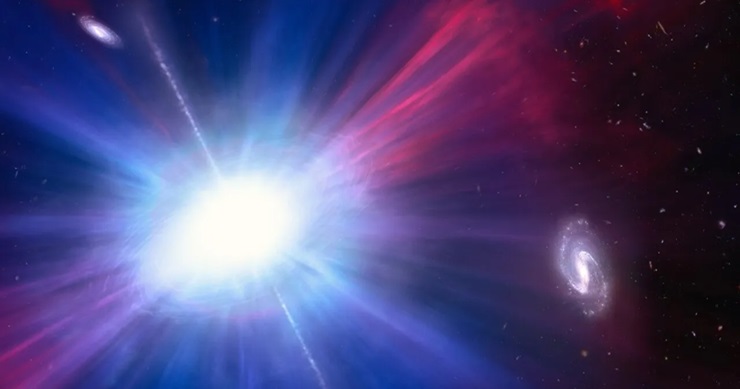A brilliant flash of light, one of the brightest blue bursts in the universe, was detected in the space between two galaxies over 3 billion light-years away. This rare astronomical event, known as a luminous fast blue optical transient (LFBOT), lasted only a few days. The first LFBOT, discovered in 2018, was up to 100 times brighter than a typical supernova and was also bright in radio waves, ultraviolet, and X-rays. These events are usually discovered at a rate of about one per year, and they are nicknamed after animals based on the last three letters in their designation.
The latest LFBOT, detected by the Zwicky Transient Facility at Palomar Observatory in California on April 10, was designated AT2023fhn and has been nicknamed “the Finch.” After its initial detection, a sequence of observations by telescopes on the ground and in space was enacted. The Gemini South telescope in Chile measured the Finch’s spectrum and found that it was 20,000 degrees Celsius (about 36,000 degrees Fahrenheit), which is hot but not as hot as some massive stars or a supernova.
Unlike previous LFBOTs, which have been observed in the spiral arms of galaxies, the Hubble Space Telescope observed that the Finch was in intergalactic space, about 50,000 light-years from one large spiral galaxy and 15,000 light-years from a small galaxy. This location seems to contradict the possibility that it could be the supernova of an exploding massive star, as massive stars only live a few million years before going supernova, which is not enough time for a star to get all the way out there.
Two possible explanations are being considered for the Finch. One is that it was a flash of light caused by a star being torn apart by an intermediate-mass black hole, which is a black hole with a mass between 100 and a few thousand times the mass of the sun. Alternatively, the Finch might have been a kilonova, which is the explosion resulting from the collision of two neutron stars (or sometimes between a neutron star and a black hole). The Laser Interferometer Gravitational-Wave Observatory was not operating at the time to detect any possible gravitational waves, or ripples in spacetime, from a neutron star merger. No associated gamma-ray burst was detected.
The discovery of the Finch poses many more questions than it answers. More research is needed to determine which of the many possible explanations is the correct one. The findings have been accepted for publication in the journal Monthly Notices of the Royal Astronomical Society.
Key Takeaways:
- An unusual cosmic explosion, known as a luminous fast blue optical transient (LFBOT), was observed in the space between two galaxies, over 3 billion light-years away, creating a brief, bright burst of blue light.
- Unlike previous LFBOTs, which were observed within galaxies, this latest one, nicknamed “the Finch”, was observed in intergalactic space, challenging current understanding of these phenomena.
- Two potential explanations for “the Finch” are that it was a flash of light caused by a star being torn apart by an intermediate-mass black hole, or it was a kilonova, an explosion resulting from the collision of two neutron stars or a neutron star and a black hole.
“The more we learn about LFBOTs, the more they surprise us,” Ashley Chrimes, a research fellow at the European Space Agency and lead author of a new paper describing the recently observed LFBOT, said. “We’ve shown that LFBOTs can occur a long way from the center of the nearest galaxy, and the location of the Finch is not what we expect for any kind of supernova.”
More details: here


Leave a Reply